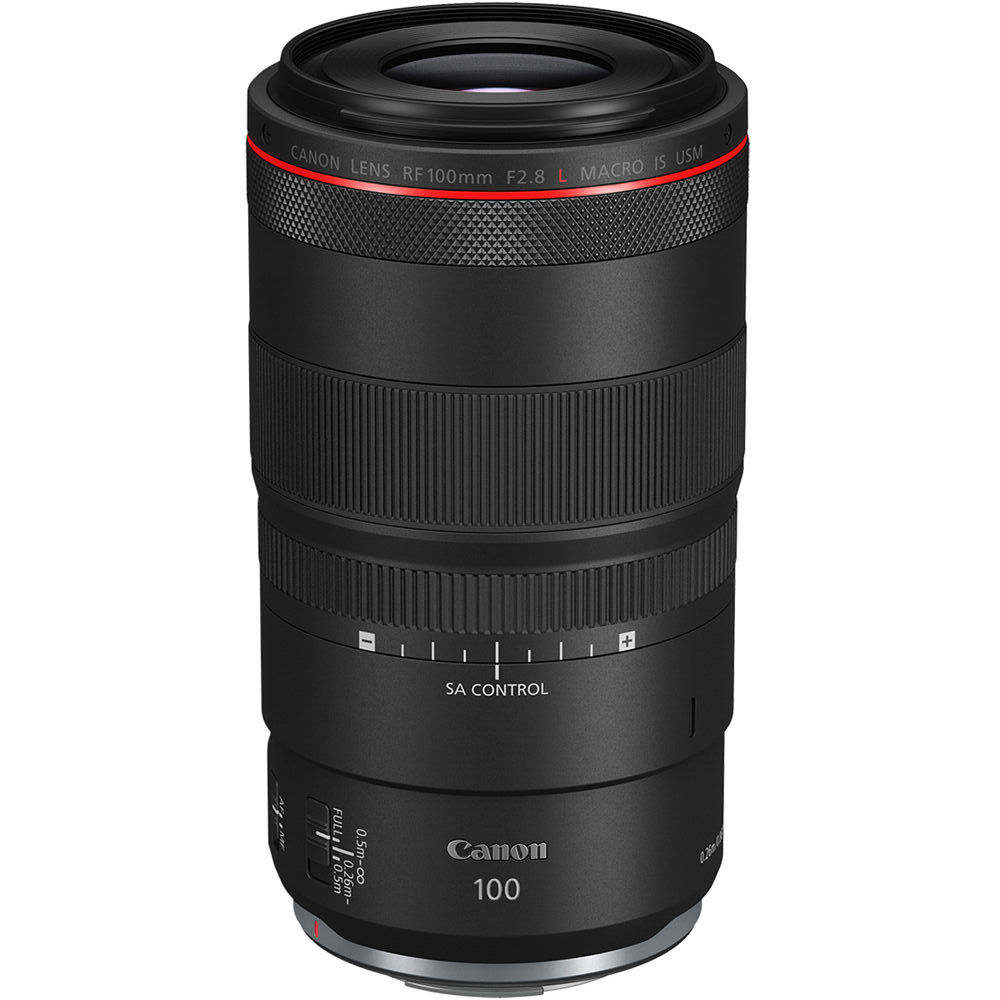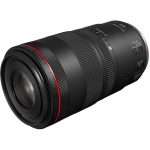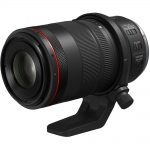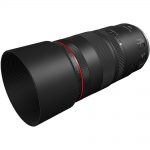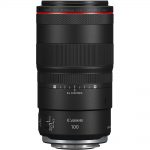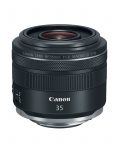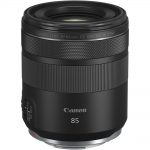Canon RF 100mm F/2.8L Macro IS USM
Macro lens • Digital era
Abbreviations
| RF | The lens is designed for Canon EOS R 35mm digital mirrorless cameras but can be also used on Canon EOS R APS-C digital mirrorless cameras. |
| L | Professional lens with high quality optics and robust build. Meets the highest standards and provides excellent performance and flawless image quality unachievable with traditional optical technologies. |
| MACRO | Macro lens. Designed specially for shooting close-ups of small subjects but can be also used in other genres of photography, not necessarily requiring focusing at close distances. Learn more |
| IS | The lens is equipped with Image Stabilizer. |
| USM | The lens is equipped with Ultrasonic Motor. |
Features highlight




Specification
| Production details: | |
| Announced: | April 2021 |
| Production status: | ● In production |
| Original name: | CANON LENS RF 100mm F2.8 L MACRO IS USM |
| System: | Canon EOS R (2018) |
| Optical design: | |
| Focal length: | 100mm |
| Speed: | F/2.8 |
| Maximum format: | 35mm full frame |
| Mount and Flange focal distance: | Canon RF [20mm] |
| Diagonal angle of view: | 24.4° |
| Lens construction: | 17 elements in 13 groups |
| Floating element system | |
| On Canon EOS R APS-C [1.61x] cameras: | |
| 35mm equivalent focal length: | 161mm (in terms of field of view) |
| 35mm equivalent speed: | F/4.5 (in terms of depth of field) |
| Diagonal angle of view: | 15.3° |
| Diaphragm mechanism: | |
| Diaphragm type: | Automatic |
| Aperture control: | None; the aperture is controlled from the camera |
| Number of blades: | 9 (nine) |
| Focusing: | |
| Closest focusing distance: | 0.26m |
| Closest working distance: | 0.086m |
| Magnification ratio: | 1:1.4 at the closest focusing distance |
| Focusing modes: | Autofocus, manual focus |
| Autofocus motor: | Dual Nano Ultrasonic Motor (Double Focusing) |
| Manual focus control: | Focusing ring |
| Focus mode selector: | AF - MF |
| Full-Time Manual Focus (FTM): | Determined by the camera |
| Focusing distance range limiter: | FULL;0.26-0.5;0.5- |
| Image Stabilizer (IS): | |
| Built-in IS: | Yes |
| IS features: | Mode 1 |
| Panning Detection | |
| Hybrid IS | |
| IS efficiency: | up to 5 stops |
| Physical characteristics: | |
| Weight: | 730g |
| Maximum diameter x Length: | ⌀81.5×148mm |
| Weather sealing: | Dust-proof and water-resistant barrel |
| Fluorine coating: | Front and rear elements |
| Accessories: | |
| Filters: | Screw-type 67mm |
| Lens hood: | ET-73C - Bayonet-type round |
| Teleconverters: | Not compatible |
| Source of data: | |
| Manufacturer's technical data. | |
Manufacturer description #1
The Canon RF100mm F2.8 L Macro IS USM lens is not only Canon’s first RF lens designed specifically for macro photography, but also the world’s first medium telephoto macro lens with a maximum magnification of 1.4x. The new lens, designed for both advanced photo enthusiasts and professionals, takes macro photography expression to the next level with the introduction of a spherical aberration (SA) control ring. The SA control ring allows users to change the character and appearance of the bokeh and obtain a softer focus effect with a simple turning of the ring to the desired result. Additional features of the Canon RF100mm F2.8L Macro IS USM include:
- Optical Image Stabilizer with up to five stops of Shake Correction.
- When combined with a camera featuring In-Body Image Stabilizer, up to eight stops of shake correction is possible with coordinated operation of Optical and In-Body Image Stabilizer.
- Hybrid IS helps to compensate for angular and shift camera shake during macro shooting.
- High-speed, smooth and quiet auto focus with dual nano USM.
- Customizable control ring that allows photographers to adjust exposure compensation, shutter speed, aperture or ISO.
- Rugged Canon L-series dust and water-resistant design.
Manufacturer description #2
Engineered specifically for full-frame EOS R series cameras, the RF100mm F2.8 L MACRO IS USM is the world’s first medium telephoto macro lens delivering close-up imagery at up to 1.4x magnification with autofocus. Featuring a fixed 100mm focal length, a bright f/2.8 maximum aperture for blurred backgrounds and low light shooting, fast, highly-precise AF, and an SA (spherical aberration) Control Ring, the RF100mm F2.8 L MACRO IS USM lens elevates the look of portraits and macro shots with the option of creating dreamlike or romantic images with a soft focus look. With strong built-in optical image stabilization and Canon's Hybrid IS system, close-up shooting and video are sharp and stable. Using the RF100mm F2.8 L MACRO IS USM, imagemakers can expect to see stunning results that can enhance their creative/artistic vision.
The RF100mm F2.8 L MACRO IS USM Lens is the world’s first medium telephoto AF Macro lens with a maximum magnification ratio of 1.4x. At its minimum focusing distance of 0.86 ft. / 0.26m, the RF100mm F2.8 L MACRO IS USM is capable of capturing detailed images while being remarkably versatile in operation. Whether capturing details of food, jewelry, or traditional macro shots, the RF100mm F2.8 L MACRO IS USM is a highly effective lens for macro photography.
The RF100mm F2.8 L MACRO IS USM lens distinguishes itself by maintaining incredibly high image quality, edge-to-edge, even wide open at its f/2.8 maximum aperture. With 17 elements in 13 groups and a 9-blade aperture system, it can deliver detailed images with gorgeous background blur and versatility in low light.
Weighing approx. 1.6 lbs. and measuring 5.83 inches in length, the RF100mm F2.8 L MACRO IS USM lens designed for comfortable use on any EOS R series camera. With its 100mm fixed focal length, the RF100mm F2.8 L MACRO IS USM lens provides a great representation to capture impressive portraits, food photos, flowers and more with minimal distortion.
Because RF lenses are designed specifically for the RF Mount found on EOS R series cameras, the lens and camera combine to share shooting data, helping to dramatically reduce the effect of camera shake that can occur when using handheld. This applies when capturing both stills and video, with up to 5 stops of stabilization for accurate and clear imagery.
Equipped with the Hybrid IS technology, the Image Stabilizer of the RF100mm F2.8 L MACRO IS USM effectively reduces blurring in handheld macro photography by compensating for both angle and shift camera shake. This helps to deliver impressively clear, up-close results.
The RF100mm F2.8 L MACRO IS USM features Canon’s first adjustable Spherical Aberration (SA) control ring on the lens barrel that allows you to adjust the depiction of the image’s background bokeh. Used to add a unique emphasis to your imagery, the SA Control Ring allows the user to change the shape and character of the foreground and background bokeh. A minus setting creates a dreamy, soft-focused look, while a Plus setting creates a bubble-bokeh-type look. Adding a third ring to the lens, the SA Control Ring has a notable surface that can be differentiated from the Control Ring and Focusing Ring. A lock mechanism can be found on the side of the lens which locks the SA control ring to the middle position rendering standard, traditional operation, with no SA optical effects.
Note: The effect of the SA control ring also changes depending on the aperture value. The effect is greatest at maximum aperture, and the effect decreases as the aperture is stopped down. (To obtain the desired effect, shooting with Aperture Priority AE is recommended). The effect of the SA control ring depends on the subject conditions (subject and background, foreground distance, etc.).
When combined with an EOS R series camera equipped with In-Body Image Stabilizer, the lens' Optical Image Stabilizer teams up with the In-Body Image Stabilizer to provide coordinated IS up to 8 stops, further helping to alleviate shaking for photos and video, and adjusting the ratio from optical to in-body stabilization automatically throughout the zoom range so you have the best of both worlds.
The RF100mm F2.8 L MACRO IS USM is equipped with dual independent Nano USMs to help achieve high-speed and focus accuracy throughout its focusing range. This helps you quickly focus and keep up with fast-moving subjects as well as provides smooth and virtually silent autofocus while shooting movies, so there is relatively no disturbance for you, the subject or in what you see visually and hear audibly during shooting and playback.
The RF100mm F2.8 L MACRO IS USM lens has a separate, independent Control Ring that is located towards the front of the lens, which can be programmable for immediate exposure adjustments during still and video shooting. With the Control Ring, you can directly adjust settings such as shutter speed, lens aperture, exposure compensation and more. For photographers and moviemakers who would prefer a silent control ring, the clicking mechanism can be removed by a Canon service provider for a fee.
For reliable performance even when weather conditions get difficult, the RF100mm F2.8 L MACRO IS USM lens features dust- and weather-resistant construction in the lens mount, switch panel and all rings. Sealing is applied to lens joining sections, and switch panels to help prevent water and dust from entering into the lens.
The RF100mm F2.8 L MACRO IS USM lens features fluorine coatings on the front and rearmost surfaces to help prevent dirt and dust from sticking to the lens, making it easy to clean smudges and fingerprints off.
Manufacturer description #3
On 14 April 2021, Canon announced the RF100mm f/2.8L Macro IS USM, its first true macro lens for the RF mount. The lens design harnesses the flexibility afforded by the RF mount’s large mount diameter and short back focus distance to achieve new possibilities, such as a maximum magnification of 1.4x and a Spherical Aberration (SA) control ring that allows users to achieve soft focus effects. Read on to learn more about this new red-line (L-series) medium telephoto macro lens that realises both excellent image quality and unprecedented functionality.
World’s first lens in its class to achieve 1.4x magnification
The RF100mm f/2.8L Macro IS USM is a 100mm medium telephoto macro lens. Macro lenses in this class usually have a maximum magnification of 1x (life size), which means that a subject that is 1cm long will be depicted as 1cm on the image sensor.
To capture close-ups of a subject so that it fills more of the frame, your first instinct would be to move closer to it. However, on all lenses, there is a closest focusing distance, i.e., a limit on how close you can be before the lens becomes unable to focus. On the RF100mm f/2.8L Macro IS USM, this closest focusing distance is 26cm, shorter than the 30cm on the EF100mm f/2.8L Macro IS USM. This achieves a larger maximum magnification of up to 1.4x—more than life size—even while retaining the same focal length.
On the RF100mm f/2.8L Macro IS USM, you can achieve the usual life size 1.0x magnification from focusing distance 28cm. Moving just 2cm closer to the 26cm closest focusing distance lets you achieve the 1.4x magnification. The working distance for both magnification ratios is 11.2cm and 9.2cm respectively, leaving enough space in between to ensure sufficient lighting.
How did Canon manage to achieve the world’s first 100mm macro lens capable of up to 1.4x magnification? The answer lies in the characteristics of the RF mount, namely, the large mount diameter and short back focus distance, which allowed more flexibility in optical design. The resulting changes to the design and AF drive dynamics of the focus and floating lens groups made it possible to carry out fast, precise focusing from nearer than before.
The electronic floating focus control system: Achieving more than just fast, accurate AF
On the RF100mm f/2.8L Macro IS USM, the autofocus (AF) is driven by two independent Nano USMs that make possible an electronic floating focus control system where the focusing lens group and the floating lens groups are controlled separately. This enables the RF100mm f/2.8L Macro IS USM to balance improved functionalities such as a shorter closest focusing distance and spherical aberration control alongside core performance qualities such fast, high-precision AF. The electronic floating focus system also helps to reduce focus breathing, which causes the angle of view to change during focusing.
The Nano USM (Ultrasonic Motor) is characterised by its capacity to perform both quick and precise movements, which are unique to a linear ultrasonic motor. This makes it capable not just of swift subject acquisition when shooting still images but also seamless subject tracking when shooting videos, therefore ensuring that viewers don’t feel uneasy when watching the video playback. Indeed, the AF capabilities of the RF100mm f/2.8L Macro IS USM also make it an excellent video lens.
Know this: What is an electronic floating focus system?
The rendering performance of a lens is usually not the same across all shooting distances—even for prime lenses with their reputation for being particularly sharp. At the design stage, the engineers will first determine a benchmark shooting distance, and then correct lens aberrations so that the image quality is the best at that “sweet spot”. This results in a reduced correction effect at shooting distances outside this sweet spot.
One of the solutions for this issue is to adopt a floating lens system, which involves moving a lens group other than the focusing lens group during focus adjustment. Such a system also improves lens aberration correction and close-up shooting capabilities.
While the EF100mm f/2.8L Macro IS USM had a mechanical system that used barrel-shaped cam gears, allowing movement only along one track, the Nano USMs on the RF100mm f/2.8L Macro IS USM, which are driven by high-performance microprocessors, can move on a variety of tracks. This, together with the RF mount design that affords more space to move the floating lens group, contributed to the significant improvement in functionality and performance on the RF100mm f/2.8L Macro IS USM.
SA control ring: Create soft focus images when you wish
A unique feature on the RF100mm f/2.8L Macro IS USM is the SA (Spherical Aberration) control ring, which utilises the electronic floating focus system to allow users to control the degree of spherical aberration correction.
Spherical aberration is usually believed to cause image quality deterioration, but it also affects how bokeh is rendered, i.e. its “flavour”. For example, the unique “bubble bokeh” with hard outlines rendered by vintage lenses, considered beautiful by some people, partly results from the under-correction of spherical aberration due to technological limits in the past. The more spherical aberration is corrected, the smoother the bokeh rendered, which eventually results in the soft focus effect.
On the RF100mm f/2.8L Macro IS USM, the use of Nano USMs makes it possible to control the floating lens group independently from the focusing group. This enables unprecedented control over the degree of spherical aberration correction without affecting the focus position. By turning the SA control ring, users can change how the bokeh in front of and behind the focal plane looks—whether it’s hard, vintage-style bokeh or soft, buttery bokeh—providing greater variety of expression.
Turning the SA control ring towards ‘+’ or ‘-’ moves the floating lens group, so that you can intentionally allow spherical aberration:
- Turning the SA control ring towards ‘-’ softens the outlines of the bokeh behind the focal plane and hardens the outlines of the bokeh in front of the focal plane.
- Turning the SA control ring towards ‘+’ hardens the outlines of the bokeh behind the focal plane and softens the outlines of the bokeh in front of the focal plane.
The effect of the SA control ring (the amount of variability in spherical aberration) varies depending on the shooting distance. As the shooting distance decreases from the infinity focusing range to when the lens achieves life size (1x) magnification, the amount of variability increases. However, due to structural factors, the spherical aberration will not change at the 0.26m closest focusing distance.
Using the SA control ring to create the soft focus effect can give your images a unique look—even for still life, flower and portrait photography.
Hybrid IS for stabler macro images; up to 8 stops’ image stabilisation
When a subject is more than a certain distance away, angular (rotational) camera shake is more likely to occur. The usual IS (Image Stabilizer) system is designed to compensate for this kind of camera shake. However, during close-up shooting, angular camera shake is less likely to occur. Instead, shift camera shake, which occurs when the sensor plane is moved in a parallel direction to the subject, becomes more obvious. The RF100mm f/2.8L Macro IS USM is equipped with the Hybrid IS (Hybrid Image Stabilizer) system, which compensates for both angular and shift camera shake. Hybrid IS can provide as much as up to two shutter speed stops’ equivalent image stabilisation when shooting close-up at life size magnification.
When shooting from a normal shooting distance, the in-lens Optical IS system provides up to five shutter speed stops’ equivalent image stabilisation. When attached to a camera with In-Body IS such as the EOS R5 or EOS R6, Coordinated Control IS is active, correcting camera shake by up to eight shutter speed stops’ equivalent.
The excellent image quality and durability true to an L-series lens
The EF100mm f/2.8L Macro IS USM was well-acclaimed for its excellent image quality. The RF100mm f/2.8L Macro IS USM, besides incorporating various new functionalities, realises the same excellent optical performance.
While it does not use any special coatings or lens elements, it does use the same kind of glass used in fluorite lenses—high-refractive glass with unique anomalous dispersion characteristics—which effectively corrects chromatic aberrations. The lens coatings and shapes of the lens elements are optimised to reduce ghosting. These, together with the smudge-resistant fluorine coating on the front lens surfaces and the dust- and drip-resistant design ensure the excellent optical performance and durability that equips an L lens to handle various shooting environments.
Ring-type tripod mount for better stability, easier switching of camera orientations
For more secure tripod mounting, a new ring-type tripod mount that provides better stability is also available (sold separately). Attaching it to the barrel of the RF100mm f/2.8L Macro IS USM allows the camera and lens to be mounted at the centre of gravity, improving stability. When the lock screw is loosened, the camera can be rotated around the lens, allowing the photographer to change the orientation of the shot without having to tilt the tripod head.
When using a tripod, changing from a horizontal composition to vertical one usually involves tilting the tripod head. This movement causes the shooting position to change significantly, and having to re-adjust the entire setup can be cumbersome especially when shooting macro. The ring-type tripod mount allows the camera to be rotated while keeping the lens still, so that the subject stays in the centre of the composition and the optical axis is maintained even while the orientation of the shot changes.
Travellers' choice
- Fast speed (F/2.8)
- Lightweight (730g)
- Dust-proof and water-resistant barrel
- Fluorine coating on front and rear elements
- Image Stabilizer (IS)
From the editor
It quickly becomes clear from the lens specification and feature list that this is the best professional autofocus macro lens available on the market. Besides, like RF 85/2 Macro IS STM, the lens can be used not only for macro photography, but also in the genre of portrait photography, and the spherical aberration control for smoother bokeh only adds extra points.
The manufacturer description says that the closest working distance is 9.2cm, but the instruction manual states that it is 8.6cm.
Other macro lenses in the Canon EOS R system
Sorted by focal length and speed, in ascending order
Table of contents
Clickable
Pros and cons
- Fast speed
- Floating element system
- Optimized for more impressive and pleasing bokeh than conventional portrait lenses
- Magnification ratio 1:1.4 at the closest focusing distance
- Dual Nano Ultrasonic Motor (Double Focusing)
- Focusing distance range limiter (FULL;0.26-0.5;0.5-)
- 9 aperture blades
- Image Stabilizer (IS) (up to 5 stops)
- Hybrid IS
- Dust-proof and water-resistant barrel
- Fluorine coating
